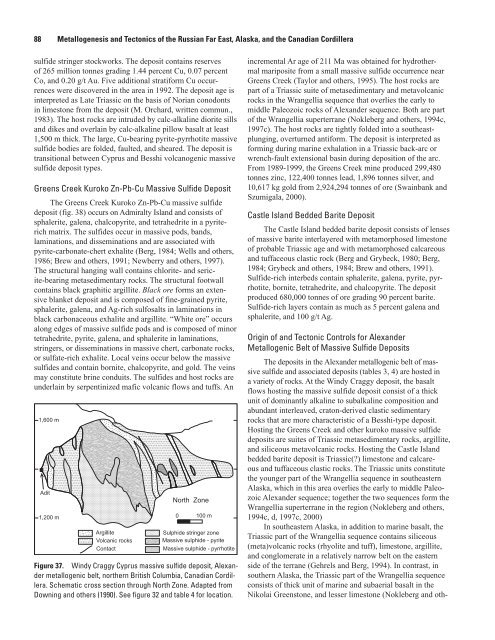USGS Professional Paper 1697 - Alaska Resources Library
USGS Professional Paper 1697 - Alaska Resources Library
USGS Professional Paper 1697 - Alaska Resources Library
Create successful ePaper yourself
Turn your PDF publications into a flip-book with our unique Google optimized e-Paper software.
88 Metallogenesis and Tectonics of the Russian Far East, <strong>Alaska</strong>, and the Canadian Cordillera<br />
sulfide stringer stockworks. The deposit contains reserves<br />
of 265 million tonnes grading 1.44 percent Cu, 0.07 percent<br />
Co, and 0.20 g/t Au. Five additional stratiform Cu occurrences<br />
were discovered in the area in 1992. The deposit age is<br />
interpreted as Late Triassic on the basis of Norian conodonts<br />
in limestone from the deposit (M. Orchard, written commun.,<br />
1983). The host rocks are intruded by calc-alkaline diorite sills<br />
and dikes and overlain by calc-alkaline pillow basalt at least<br />
1,500 m thick. The large, Cu-bearing pyrite-pyrrhotite massive<br />
sulfide bodies are folded, faulted, and sheared. The deposit is<br />
transitional between Cyprus and Besshi volcanogenic massive<br />
sulfide deposit types.<br />
Greens Creek Kuroko Zn-Pb-Cu Massive Sulfide Deposit<br />
The Greens Creek Kuroko Zn-Pb-Cu massive sulfide<br />
deposit (fig. 38) occurs on Admiralty Island and consists of<br />
sphalerite, galena, chalcopyrite, and tetrahedrite in a pyriterich<br />
matrix. The sulfides occur in massive pods, bands,<br />
laminations, and disseminations and are associated with<br />
pyrite-carbonate-chert exhalite (Berg, 1984; Wells and others,<br />
1986; Brew and others, 1991; Newberry and others, 1997).<br />
The structural hanging wall contains chlorite- and sericite-bearing<br />
metasedimentary rocks. The structural footwall<br />
contains black graphitic argillite. Black ore forms an extensive<br />
blanket deposit and is composed of fine-grained pyrite,<br />
sphalerite, galena, and Ag-rich sulfosalts in laminations in<br />
black carbonaceous exhalite and argillite. “White ore” occurs<br />
along edges of massive sulfide pods and is composed of minor<br />
tetrahedrite, pyrite, galena, and sphalerite in laminations,<br />
stringers, or disseminations in massive chert, carbonate rocks,<br />
or sulfate-rich exhalite. Local veins occur below the massive<br />
sulfides and contain bornite, chalcopyrite, and gold. The veins<br />
may constitute brine conduits. The sulfides and host rocks are<br />
underlain by serpentinized mafic volcanic flows and tuffs. An<br />
1,600 m<br />
Adit<br />
1,200 m<br />
Argillite<br />
Volcanic rocks<br />
Contact<br />
North Zone<br />
0 100 m<br />
Sulphide stringer zone<br />
Massive sulphide - pyrite<br />
Massive sulphide - pyrrhotite<br />
Figure 37. Windy Craggy Cyprus massive sulfide deposit, Alexander<br />
metallogenic belt, northern British Columbia, Canadian Cordillera.<br />
Schematic cross section through North Zone. Adapted from<br />
Downing and others (1990). See figure 32 and table 4 for location.<br />
incremental Ar age of 211 Ma was obtained for hydrothermal<br />
mariposite from a small massive sulfide occurrence near<br />
Greens Creek (Taylor and others, 1995). The host rocks are<br />
part of a Triassic suite of metasedimentary and metavolcanic<br />
rocks in the Wrangellia sequence that overlies the early to<br />
middle Paleozoic rocks of Alexander sequence. Both are part<br />
of the Wrangellia superterrane (Nokleberg and others, 1994c,<br />
1997c). The host rocks are tightly folded into a southeastplunging,<br />
overturned antiform. The deposit is interpreted as<br />
forming during marine exhalation in a Triassic back-arc or<br />
wrench-fault extensional basin during deposition of the arc.<br />
From 1989-1999, the Greens Creek mine produced 299,480<br />
tonnes zinc, 122,400 tonnes lead, 1,896 tonnes silver, and<br />
10,617 kg gold from 2,924,294 tonnes of ore (Swainbank and<br />
Szumigala, 2000).<br />
Castle Island Bedded Barite Deposit<br />
The Castle Island bedded barite deposit consists of lenses<br />
of massive barite interlayered with metamorphosed limestone<br />
of probable Triassic age and with metamorphosed calcareous<br />
and tuffaceous clastic rock (Berg and Grybeck, 1980; Berg,<br />
1984; Grybeck and others, 1984; Brew and others, 1991).<br />
Sulfide-rich interbeds contain sphalerite, galena, pyrite, pyrrhotite,<br />
bornite, tetrahedrite, and chalcopyrite. The deposit<br />
produced 680,000 tonnes of ore grading 90 percent barite.<br />
Sulfide-rich layers contain as much as 5 percent galena and<br />
sphalerite, and 100 g/t Ag.<br />
Origin of and Tectonic Controls for Alexander<br />
Metallogenic Belt of Massive Sulfide Deposits<br />
The deposits in the Alexander metallogenic belt of massive<br />
sulfide and associated deposits (tables 3, 4) are hosted in<br />
a variety of rocks. At the Windy Craggy deposit, the basalt<br />
flows hosting the massive sulfide deposit consist of a thick<br />
unit of dominantly alkaline to subalkaline composition and<br />
abundant interleaved, craton-derived clastic sedimentary<br />
rocks that are more characteristic of a Besshi-type deposit.<br />
Hosting the Greens Creek and other kuroko massive sulfide<br />
deposits are suites of Triassic metasedimentary rocks, argillite,<br />
and siliceous metavolcanic rocks. Hosting the Castle Island<br />
bedded barite deposit is Triassic(?) limestone and calcareous<br />
and tuffaceous clastic rocks. The Triassic units constitute<br />
the younger part of the Wrangellia sequence in southeastern<br />
<strong>Alaska</strong>, which in this area overlies the early to middle Paleozoic<br />
Alexander sequence; together the two sequences form the<br />
Wrangellia superterrane in the region (Nokleberg and others,<br />
1994c, d, 1997c, 2000)<br />
In southeastern <strong>Alaska</strong>, in addition to marine basalt, the<br />
Triassic part of the Wrangellia sequence contains siliceous<br />
(meta)volcanic rocks (rhyolite and tuff), limestone, argillite,<br />
and conglomerate in a relatively narrow belt on the eastern<br />
side of the terrane (Gehrels and Berg, 1994). In contrast, in<br />
southern <strong>Alaska</strong>, the Triassic part of the Wrangellia sequence<br />
consists of thick unit of marine and subaerial basalt in the<br />
Nikolai Greenstone, and lesser limestone (Nokleberg and oth-
















